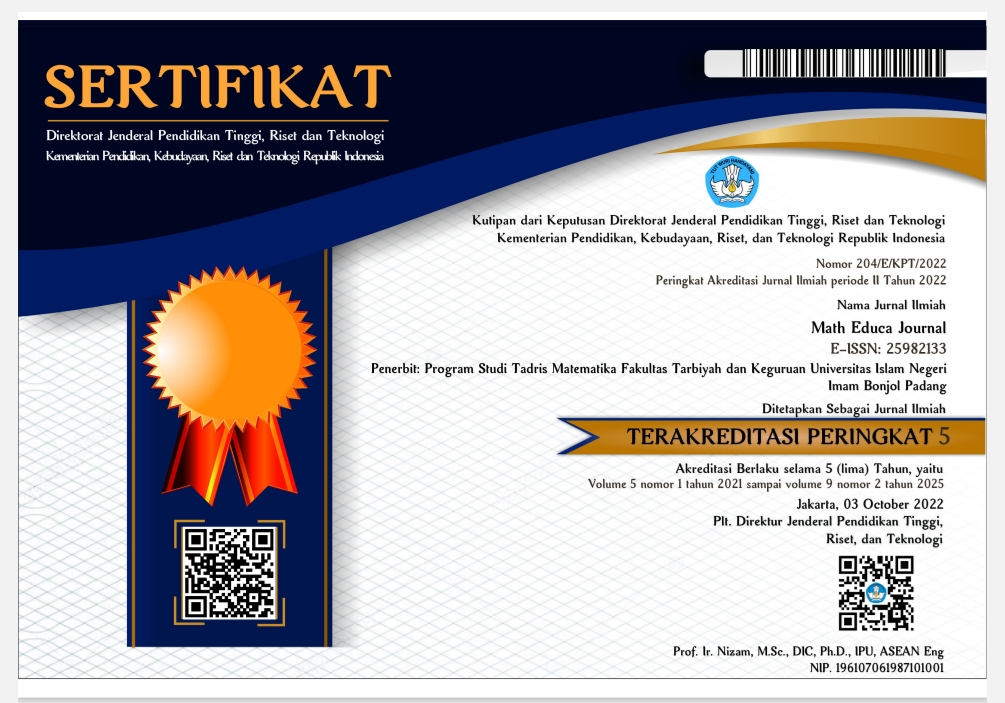Pengaruh Permainan Konstruktif dan Kecerdasan Visual- Spasial Terhadap Kemampuan Matematika Awal Anak Usia Dini
Abstract
Keywords
Full Text:
PDFReferences
Brosnan, M. J. (2011). Spatial Ability in Children’s Play with Lego Blocks. Perceptual and Motor Skills, 87(1), 19–28.
Casey, B. M., Pezaris, E. E., & Bassi, J. (2012). Adolescent boys’ and girls’ block constructions differ in structural balance: A block-building characteristic related to math achievement. Learning and Individual Differences, 22(1), 25–36.
Caviola, S., Mammarella, I. C., Cornoldi, C., & Lucangeli, D. (2012). The involvement of working memory in children’s exact and approximate mental addition. Journal of Experimental Child Psychology, 112(2), 141–160.
Christakis, D. A., Zimmerman, F. J., & Garrison, M. M. (2007). Effect of Block Play on Language Acquisition and Attention in Toddlers. Archives of Pediatrics & Adolescent Medicine, 161(10), 967.
Hanline, M. F., Milton, S., & Phelps, P. C. (2010). The relationship between preschool block play and reading and maths abilities in early elementary school: A longitudinal study of children with and without disabilities. Early Child Development and Care, 180(8), 1005–1017.
Jamaris, M. (2018). Pengembangan Instrumen Baku Kecerdasan Jamak Anak Usia Dini. PARAMETER: Jurnal Pendidikan Universitas Negeri Jakarta, 25(2), 123–137.
Nath, S., & Szücs, D. (2014). Construction play and cognitive skills associated with the development of mathematical abilities in 7-year-old children. Learning and Instruction, 32, 73–80.
Organisation for Economic Co-operation and Development (OECD). (2013). PISA 2012 Assessment and Analytical Framework: Mathematics, Reading, Science, Problem Solving and Financial Literacy. OECD Report.
Ritchie, S. J., & Bates, T. C. (2013). Enduring Links From Childhood Mathematics and Reading Achievement to Adult Socioeconomic Status. Psychological Science, 24(7), 1301–1308.
Robert, M., & Héroux, G. (2004). Visuo-spatial play experience: Forerunner of visuo-spatial achievement in preadolescent and adolescent boys and girls? Infant and Child Development, 13(1), 49–78.
Schmitt, S. A., Korucu, I., Napoli, A. R., Bryant, L. M., & Purpura, D. J. (2018). Using block play to enhance preschool children’s mathematics and executive functioning: A randomized controlled trial. Early Childhood Research Quarterly, 44, 181–191.
Stannard, L., Wolfgang, C. H., Jones, I., & Phelps, P. (2001). A longitudinal study of the predictive relations among construction play and mathematical achievement. Early Child Development and Care, 167(1), 115–125.
Utami, S., Qur, N., & R, E. K. (2008). Playing Lego Increase Cognitive Development on Preschool Child ( 4-5 Years Old ). Keperawatan.
Verdine, B. N., Golinkoff, R. M., Hirsh-Pasek, K., Newcombe, N. S., Filipowicz, A. T., & Chang, A. (2014). Deconstructing Building Blocks: Preschoolers’ Spatial Assembly Performance Relates to Early Mathematical Skills. Child Development, 85(3), 1062–1076.
Wechsler, D. (2012). Wechsler preschool and primary scale of intelligence—fourth edition. Encyclopedia of Autism Spectrum Disorders, 3400–3400.
Weiland, C., Wolfe, C. B., Hurwitz, M. D., Clements, D. H., Sarama, J. H., & Yoshikawa, H. (2012). Early mathematics assessment: Validation of the short form of a prekindergarten and kindergarten mathematics measure. Educational Psychology, 32(3), 311–333.
Wolfgang. (2003). Advanced constructional play with LEGOs among preschoolers as a predictor of later school achievement in mathematics. Early Child Development and Care. https://doi.org/http://dx.doi.
Yelland. (2012). Australasian Journal of Early Childhood. 37.2 FIVE, 36(2).
Refbacks
- There are currently no refbacks.
The Journal Space of the Mathematics Education Department
Faculty of Education and Teacher Training
State Islamic University of Imam Bonjol Padang
Email: mej.uinibpadang@gmail.com

Math Educa Journal is licensed under a Lisensi Creative Commons Atribusi-NonKomersial 4.0 Internasional.
Based on a work at https://ejournal.uinib.ac.id/jurnal/index.php/matheduca.
All rights reserved p-ISSN: 2580-6726 | e-ISSN: 2598-2133




